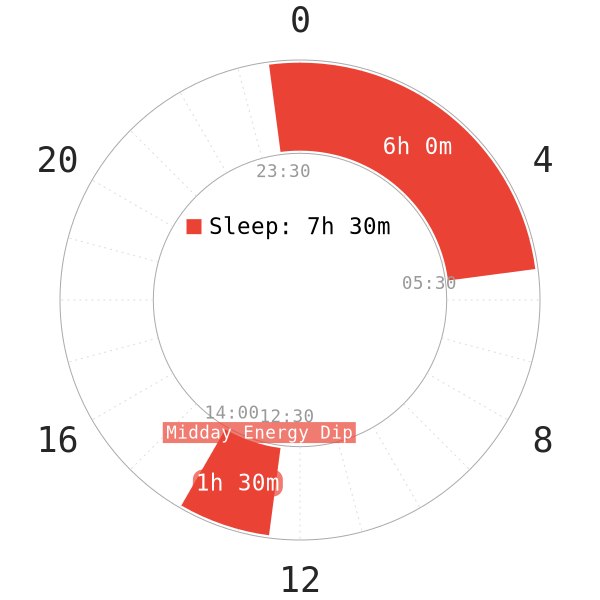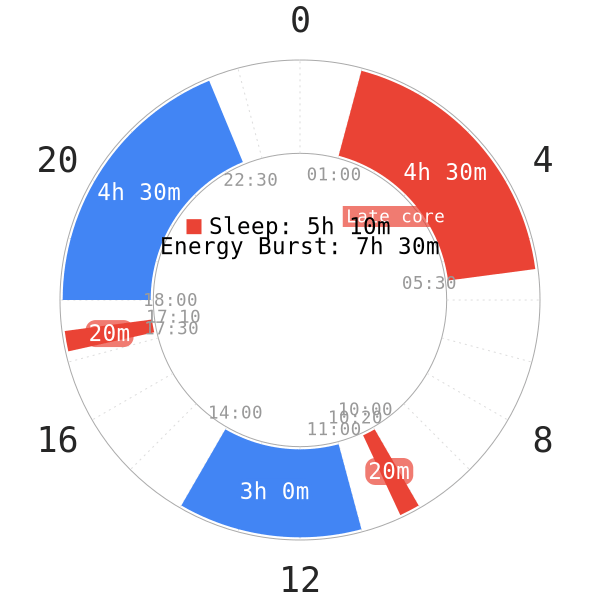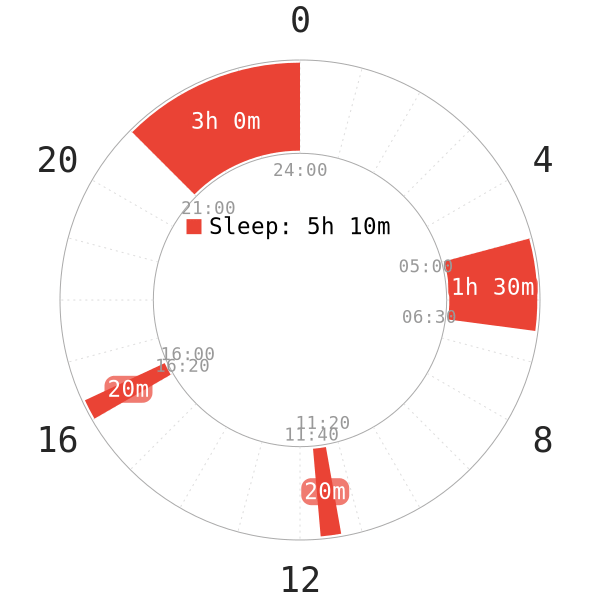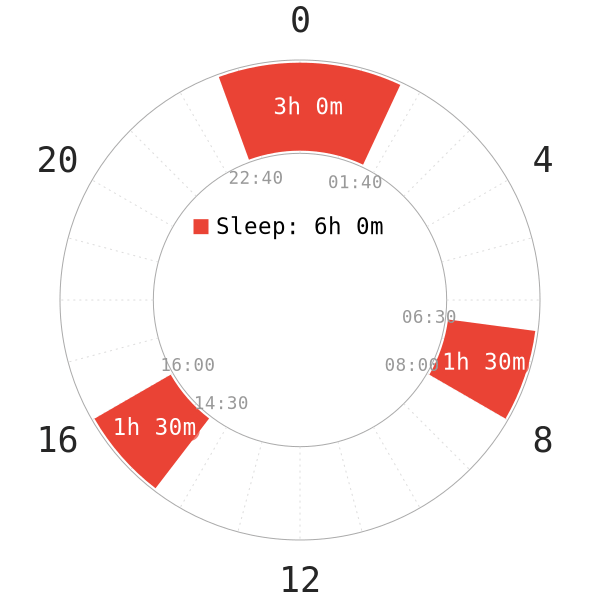Introduction
When deciding on a polyphasic schedule or diagnosing certain problems during adaptation, you may need to align with your sleep chronotype. Dr. Breus was behind the idea of sleep chronotypes. Your sleep chronotype is your genetic variation on the average circadian rhythm.
- When do you get tired?
- Most importantly, when is your best sleep and best activity level?
Bears are the most common of 4 types (approximately 50% of population) and reflect the average circadian rhythm.
- They have the standard SWS peak between 21:00-midnight, a REM peak between 06:00-09:00, and a midday energy dip between 11:00-15:00.
- They also need the most sleep on average.
- Lions are earlier Wolves are later and Dolphins have trouble sleeping regardless.
Prepare an easy, visual outline of each type at Mantasleep. To determine your type, take the online quiz at ThePowerofWhenQuiz.com .*
Notes
Please ignore elaborate personality deductions for each sleep chronotype you see in the video after the quiz. They are largely baseless and inaccurate. They abuse the Forer/Barnum psychological fallacy in contrast with other established personality identification systems. Chiefly consider the variation in circadian rhythms due to genes. Dr. Breus is a respectable sleep scientist, but not a personality psychologist.
Unlike other recommendations on Polyphasic.net, this section contains speculation with limited experience or survey results so far. That said, there are some exciting deductions to improve adaptation success! Note that the interaction is unknown between chronotypes and artificial dark period. For example, using very dim light or filtering out blue/green light for 2 hours before bedtime. These suggestions assume dark period matches your local sunlight hours.
List of sleep chronotypes
Bears (sunlight-aligned)

This chronotype may prefer sleep in the middle of their outside dark hours. In other words, they are the most sunlight-driven.
- From personal experience, you may be happiest with waking up to sunlight or an artificial sunrise alarm clock. However, this is only if your final nighttime core ends at least 5 hours after your first/only core begins. On polyphasic sleep, this could be around 23:00.
- Follow the timing of ideal polyphasic charts on Polyphasic.net and Napchart.com with +/- 1 hour adjustments.
- 50% of the population have this standard circadian rhythm, according to Dr. Breus.
- Bears also have a midday energy dip around 11:00-14:00, where a polyphasic nap or siesta is extremely useful.
Wolves (night owls)

Unlike bears, this group may do better with their late first core between midnight and 2am on a polyphasic schedule. If you one of those who complain about not being able to fall asleep earlier, even with blue light filters and low light, this may be you.
- Wolves tend to sleep in and their doze does not work with entraining a polyphasic schedule. Thus, many alarms with math puzzles and bar code scanners may be necessary to get up promptly.
- In addition, wolves get an energy burst around midday (11:00-14:00), and then more energy again in the evening. Therefore, any naps or a siesta should be concentrated earlier in the day before noon with this sleep chronotype.
Lions (early morning types)

Interestingly, lions need the earliest bedtimes.
- The first core could be 21:00 or even earlier, but not in daylight. This would suppress melatonin. Melatonin takes two hours of darkness or red-only light to peak. Therefore, you would want it to peak at the beginning of your first core cycle.
- Naps will help sustain energy throughout the day, as opposed to monophasic sleep on this sleep chronotype!
Dolphins (Difficult sleepers)

Contrary to all chronotypes, dolphins have trouble with sleep in general and are light sleepers. Thus, consider the following:
- Choose when you are calmest and the environment is most quiet. You might be able to fall asleep well if these environments fit you.
- Managing anxiety and stress is the key to this type.
- Additionally, a strict dark period is especially important to ensure a strong melatonin buildup that increases drowsiness and sleep quality. Use products like the laser goggles, red lightbulbs, or screen light filters to block blue and green light 2 hours before the desired core bedtime.
- 20-minute naps may be difficult, due to the difficulty in falling asleep quickly. If so, consider siesta or segmented schedules, or even triphasic if you are over 21.
Notably, Dr. Breus recommends a worry journal before bedtime to dump your stressful thoughts. See sleepscore.com/chronotype-ideal-bedtime. In this article, Dr. Breus also reports that:
- Early-riser Lions and especially the common Bears “tend to get” 7.5-hour monophasic core sleep.
- Nocturnal Wolves and insomniac Dolphins tend to get 6-hour monophasic core. He reports these as tendencies in practice.
- In an ideal world, based on many hundreds of newcomer welcome surveys in the leading polyphasic online server, I believe many Bears thrive on 9 hours of monophasic sleep. The other types thrive on 7.5-8 hours. Dolphins may be lucky to get that.
- Modern research advises 7-9 hours monophasic sleep for adults.
- On polyphasic sleep, Bears would be the most likely to require extended schedules with an extra 90m core cycle. Lions might benefit from the +30m core variations of certain schedules.
Sleep Pressure & Chronotypes
Most notably, personal sleep chronotype may play a role in affecting sleep pressure. Specifically, evening (Wolf) and morning (Lion) chronotypes respond differently to sleep pressure.
- Homeostatic pressure rises in evening type after 5.5h of wakefulness; the equivalent number for morning type is a whopping 11.5h1. The idea suggests that evening type is more easily prone to sleep deprivation due to staying awake late at night and waking up early. As a result, they feel the need to sleep after ~5.5h.
- Under sleep extension environment, no differences in sleep pressure are found between either types1.
- Evening type is often more sleepy around 10:30 AM-12:30 PM1. The sleep reduction at night, thus, may suggest that biphasic sleep is natural for them.
- Evening type also performs better at night (low sleep pressure at these hours) and gets better morning sleep than morning type. This is because their sleep pressure is usually high around morning hours. It may imply that Wolf shift workers can still adapt to a polyphasic sleep schedule given their ability to perform well at night.
Final thoughts
Finally, consider your daily habits and see how it fares with the recommended example days for each type. See Business Insider on how to find your perfect daily routine. How would you plan your next polyphasic lifestyle for the best energy, every day?
Main author: Aethermind
Page last updated: 18 January 2021
Reference
- Taillard, J., Philip, P., Coste, O., Sagaspe, P., & Bioulac, B. (2003). The circadian and homeostatic modulation of sleep pressure during wakefulness differs between morning and evening chronotypes. Journal of Sleep Research, 12(4), 275–282. doi:10.1046/j.0962-1105.2003.00369.x. [PubMed]
